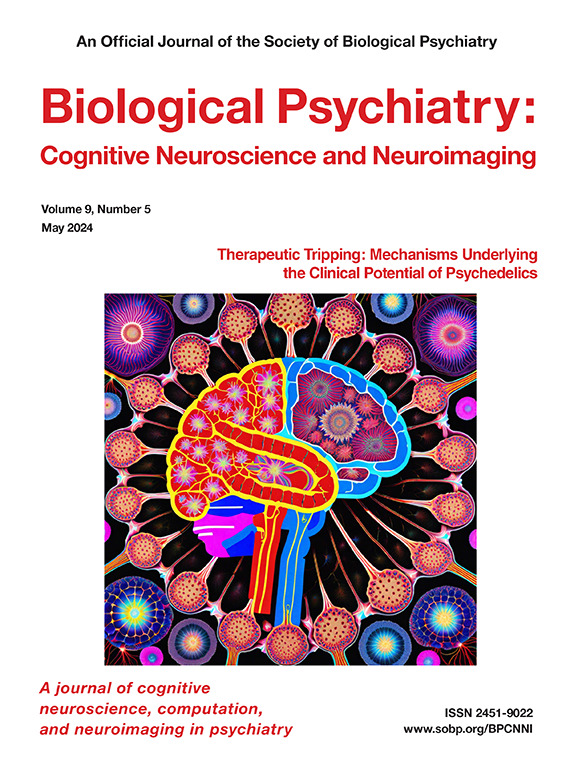The Reward Positivity As a Predictor of First-Lifetime Onsets of Depression, Anxiety, and Suicidal Ideation in High-Risk Adolescents
IF 5.7
2区 医学
Q1 NEUROSCIENCES
Biological Psychiatry-Cognitive Neuroscience and Neuroimaging
Pub Date : 2025-02-01
DOI:10.1016/j.bpsc.2024.10.017
引用次数: 0
Abstract
Background
Reduced reward positivity (RewP), an electroencephalography marker elicited by feedback indicating reward, has been associated with an increased risk for depression during adolescence. However, the ability of the RewP to predict the first-lifetime onset of depressive disorders, as opposed to anxiety and suicidal ideation in high-risk populations, has not been thoroughly investigated. In this study, we examined whether the RewP predicts the first-lifetime onset of depression, anxiety, and suicidal ideation over 18 months in familial high-risk adolescents.
Methods
The sample included 145 adolescents (64.8% female), ages 11 to 17 years, who had at least 1 parent with a history of mood or anxiety disorders and completed baseline and at least 1 follow-up measurement. At baseline, the RewP was measured using a simple gambling task; current internalizing symptoms were assessed using self-report questionnaires; and the adolescent’s psychiatric diagnoses were evaluated with diagnostic interviews. The same interview was administered to the adolescents again 9 months and 18 months later.
Results
Logistic regression models showed that higher RewP scores significantly predicted a lower likelihood of developing a first onset of major depressive disorder over 18 months, even after controlling for sex, age, and baseline internalizing symptoms. In contrast, the RewP did not significantly predict the first onset of anxiety disorders or suicidal ideation.
Conclusions
A reduced RewP precedes the first onset of depression in high-risk adolescents, highlighting the RewP’s predictive capability for depression risk in predisposed populations. A blunted RewP could complement self-reported symptoms in screening and prevention.
奖励积极性是预测高危青少年抑郁、焦虑和自杀意念终生首次发作的指标。
背景:奖赏积极性降低(RewP)是由奖赏反馈引起的脑电图(EEG)标记,它与青少年抑郁症风险增加有关。然而,RewP 在预测高危人群抑郁障碍(而非焦虑和自杀意念)的首次发病方面的预测能力尚未得到深入研究。在本研究中,作者考察了 RewP 是否能预测家族性高危青少年在 18 个月内首次出现抑郁、焦虑和自杀意念的情况:样本包括 145 名青少年(64.8% 为男性),年龄在 11-17 岁之间,父母至少一方有情绪和焦虑症病史,并完成了基线和至少一次随访测量。在基线测量中,使用简单的赌博任务测量 RewP,使用自我报告问卷评估他们当前的内化症状,并通过诊断访谈评估青少年的精神诊断。9个月和18个月后,青少年再次接受了同样的访谈:逻辑回归模型显示,即使在控制了性别、年龄和基线内化症状之后,RewP 分数越高,预测在 18 个月内首次出现重度抑郁症(MDD)的可能性就越低。相比之下,RewP并不能显著预测焦虑症或自杀倾向的首次发病:结论:RewP的降低先于高危青少年抑郁症的首次发病,这凸显了RewP在预测易感人群抑郁症风险方面的预测能力。在筛查和预防过程中,RewP减弱可作为自我报告症状的补充。
本文章由计算机程序翻译,如有差异,请以英文原文为准。
求助全文
约1分钟内获得全文
求助全文
来源期刊

Biological Psychiatry-Cognitive Neuroscience and Neuroimaging
Neuroscience-Biological Psychiatry
CiteScore
10.40
自引率
1.70%
发文量
247
审稿时长
30 days
期刊介绍:
Biological Psychiatry: Cognitive Neuroscience and Neuroimaging is an official journal of the Society for Biological Psychiatry, whose purpose is to promote excellence in scientific research and education in fields that investigate the nature, causes, mechanisms, and treatments of disorders of thought, emotion, or behavior. In accord with this mission, this peer-reviewed, rapid-publication, international journal focuses on studies using the tools and constructs of cognitive neuroscience, including the full range of non-invasive neuroimaging and human extra- and intracranial physiological recording methodologies. It publishes both basic and clinical studies, including those that incorporate genetic data, pharmacological challenges, and computational modeling approaches. The journal publishes novel results of original research which represent an important new lead or significant impact on the field. Reviews and commentaries that focus on topics of current research and interest are also encouraged.
 求助内容:
求助内容: 应助结果提醒方式:
应助结果提醒方式:


